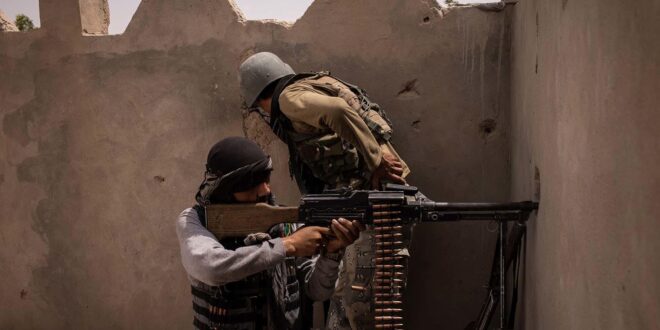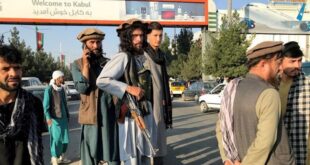No matter where the conflict goes from here, Afghans will bear enormous costs as stability looks to be a distant prospect.
The Afghan government has had its most difficult week fighting the Taliban since the insurgency began. As of this writing, 12 provincial capitals have fallen since last Friday, marking the first time the Taliban have controlled a city since they were ousted in 2001. By some estimates the Taliban control two-thirds of the country. While many experts predicted that the rapid and unconditional withdrawal of U.S. troops would increase Taliban control, few saw it happening this fast. A Taliban takeover of Kabul — once thought to be years away if at all — is now conceivable within months, or even a matter of weeks.
While Afghan government forces struggle to slow Taliban momentum, Afghan civilians are suffering most. Civilian casualties have soared during the most recent Taliban offensives and there are reports of widespread Taliban atrocities, signaling a return to the darkest times of the militant group’s rule. Recent reports of summary executions of captured Afghan soldiers, beating women who are considered to be immodestly dressed, forced marriages, and assassinations of civil society leaders and journalists have created a sense of panic among the population and led to a massive crisis of internal displacement.
What’s Next?
Looking ahead, there are three possible trajectories for the conflict:
Slow strangulation: The Taliban’s main strategy has been to occupy rural areas that are hard for the government to defend, then surround cities and increase both local fear and control. Now that strategy is playing out on a national scale, with the Taliban taking over provinces in ways that cut off major cities from each other, restrict revenue and goods into the capital, and increasingly surround and isolate Kabul. The Taliban now control most of Afghanistan’s border crossings, which denies revenue for the government and enables the Taliban to tax trade to fund their fighting. A map of Taliban controlled districts illustrates how much Kabul is surrounded to the north, south and west. The only safe route out is east to Jalalabad and Pakistan. One can assume the Taliban will focus on that next. An encirclement strategy aims to sap the government’s strength over time. The idea is that with enough pressure and deprivation, the government will sue the Taliban for peace and give the Taliban most of what they want in the process. This will be a victory for the Taliban but could result in some balance of power that different ethnic and political factions can accept.
The Tipping Point: A quicker scenario leading to a Taliban takeover involves the Taliban reaching a psychological tipping point whereby their ultimate victory appears to be inevitable to a critical mass of political leaders and power brokers who then switch sides or surrender rapidly to avoid costly fighting or persecution under a new political order. In many cases, this has already occurred — with reports of posts being abandoned or surrendered outnumbering cases of pitched battles. Historically, this is how power has often changed hands in Afghanistan. In 1996, what seemed like a steady but slow Taliban advance quickly became a rout when Kabul’s defenses collapsed and the Taliban were able to advance into the city with barely a days’ notice. This scenario seems more and more likely in light of the Taliban’s recent rapid advances. It would provide the Taliban with maximal gains and would likely lead to a return of their self-declared Emirate — or something close to it.
Bouncing off rock bottom: A more hopeful scenario is that the Afghan government and an anti-Taliban coalition of political leaders will be galvanized by the existential threat the group’s advances pose to the state and their way of life and will unite in a more coordinated and spirited opposition. President Biden seemed to count on this scenario when he noted on Tuesday that the United States was continuing to provide Afghan National Defense and Security Forces (ANDSF) with air support and other resources, but said, “They’ve got to want to fight.” President Ghani met with leaders in Mazar-e-Sharif on Wednesday in an attempt to pool resources and increase political motivation for northern constituencies to fight back against Taliban gains. The concern is that this effort at political unity may be too little, too late. If the ANDSF can hold back the Taliban from capturing the biggest cities and all transport routes, it will provide time for Afghan forces to adjust to the new reality of fighting without U.S. and NATO enablers and take the fight back to the Taliban. This would still leave a grinding war of attrition, but one that is more likely to produce the kind of battlefield stalemate that makes productive peace negotiations more likely.Unfortunately, all of these scenarios have enormous human costs for Afghans and are unlikely to produce stability any time soon. If the Afghan government holds out, it will remain weak and fragile and Taliban momentum will need to be reversed or stopped for a while before it is likely to negotiate any serious compromise political settlement.
If the Taliban are able to take control more rapidly, it will face even more daunting governance challenges: the Taliban alienate some ethnic groups, the vast majority of Afghan citizens do not want to live under their rule, they are unlikely to attract significant donor aid given recent atrocities and repressive policies, and they have no apparent plan or experience running a modern state. Even if it takes some time for routed anti-Taliban forces to regroup, a counter-revolution seems inevitable unless a balanced and inclusive political settlement can be reached.
Where to Go From Here?
Slowing the Taliban’s momentum is no easy task — but no one in the region wants to see a Taliban takeover or benefits from the aftermath of the fall of Kabul. As the Taliban advances, Washington should do the following:
Extend its “over-the-horizon” support for the ANDSF. The United States has already conducted limited air strikes to blunt Taliban offensives against major cities but is still deciding whether to continue after August 31 when President Biden declared all troops would be out of the country. Maintaining strikes after that date would not only provide critical support but also boost morale. And once the Taliban seek to hold checkpoints and occupy their own bases it should be easier to target them and help the Afghan forces regain territory, creating a change in momentum. The surprise announcement on Thursday that 3,000 U.S. troops are being sent to secure the Kabul airport for evacuations could also bolster Afghan military morale.
Describe clear consequences for Taliban human rights atrocities. The U.S. Embassy tweeted last week that it was tracking reports of war crimes and other atrocities by the Taliban but Washington has not laid out a specific plan to deter atrocities. Washington should call on the U.N. Human Rights Commission to conduct a formal fact-finding mission into alleged atrocities and make it clear that sanctions on Taliban leaders will increase if war crimes or other atrocities occur under their leadership. The United States should also provide greater funding for human rights monitoring and investigation by Afghan organizations on the ground.
Call for a U.N. Security Council resolution that authorizes U.N. facilitation of a peace process. As the U.N. Afghanistan mission’s Special Representative of the Secretary-General Deborah Lyons argued at a special session of the U.N. Security council last week, the situation in Afghanistan has become a threat to regional stability and international security that requires greater U.N. attention. All five permanent members of the Security Council agree that a Taliban takeover by force is illegitimate and the Afghan parties must negotiate a political settlement to avoid a broader regional crisis. This should be reinforced with the full weight of the Security Council and a U.N. facilitator should be appointed to give more urgency to intra-Afghan talks.
Rally regional support for intra-Afghan talks. Outside of Afghans themselves, Afghanistan’s neighbors have the most at stake from the Taliban’s potential violent takeover, which would disrupt regional trade, lead to a massive exodus of refugees and could lead to destabilizing proxy wars. At conferences this year in Moscow and Doha, Russia, China and Pakistan all affirmed that the future of Afghanistan should be decided through dialogue and political negotiations. Now more than ever, these regional players must exert whatever leverage they have to bring the Afghan parties to the table and the United States should provide incentives for them to do so.
Deny the Taliban legitimacy if they take power by force. The Taliban have relished the international attention their negotiators have received by global diplomats trying to establish an inclusive political settlement. But so far they have not put forward any plan for compromise while their forces march on Kabul. The international community should deny the Taliban travel privileges from Doha as long as fighting supersedes intra-Afghan talks. The United States and its allies should also make clear to the Taliban that if they do take Kabul by force, the movement will not be recognized as a legitimate government and it will lose all but humanitarian assistance.  Eurasia Press & News
Eurasia Press & News




